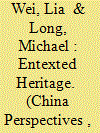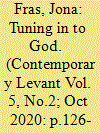| Srl | Item |
| 1 |
ID:
181904


|
|
|
|
|
| Summary/Abstract |
From medieval times to the present, calligraphy has been theorised as a product of “spirit” rather than of the hand, and has been situated atop the Chinese aesthetic hierarchy. Recognising calligraphy as a key aspect of national identification, the People’s Republic of China applied for its recognition to the Representative List of the Intangible Cultural Heritage of Humanity. Through the process of constructing calligraphy as Intangible Cultural Heritage (ICH), a simplified calligraphic canon emerged, which epitomises the “correct spirit of tradition.” Building on art historical and anthropological questions of transmission and authentication of the classical tradition of calligraphy, this paper challenges this idealised conceptualisation by investigating how a contemporary Chinese ICH regime has worked to “entextualise” calligraphy into present social and political circumstances.
|
|
|
|
|
|
|
|
|
|
|
|
|
|
|
|
| 2 |
ID:
175145


|
|
|
|
|
| Summary/Abstract |
Sound and spoken language play a major role in contemporary Islamic media. On Islamic advice programmes in Jordan, a genre of radio show in which listeners call in to the station with questions regarding pious Sunni Muslim conduct, broadcasters use language in ways that conveys authority to the Islamic textual tradition, and therefore presents their responses as legitimate advice for pious Muslims. By manipulating the language of quotations, broadcasters both ‘entextualise’ segments of language and develop dialogical relationships with Islamic texts – principally, the Qur’an and hadith literature – as well as the audiences addressed and co-present callers. Though the programmes provide a forum for public discussion of religious issues, a linguistic anthropological analysis nevertheless reveals the persistent asymmetry and exclusion inherent in this type of mediated interaction: hosts remain supremely authoritative dispensers of advice to lay callers, and the programme’s listenership is idealised as a pious Jordanian Sunni Muslim audience from which non-devout individuals are excluded. Details of communicative interaction must, therefore, be given careful attention when examining the role of religious media in the contemporary Middle East.
|
|
|
|
|
|
|
|
|
|
|
|
|
|
|
|